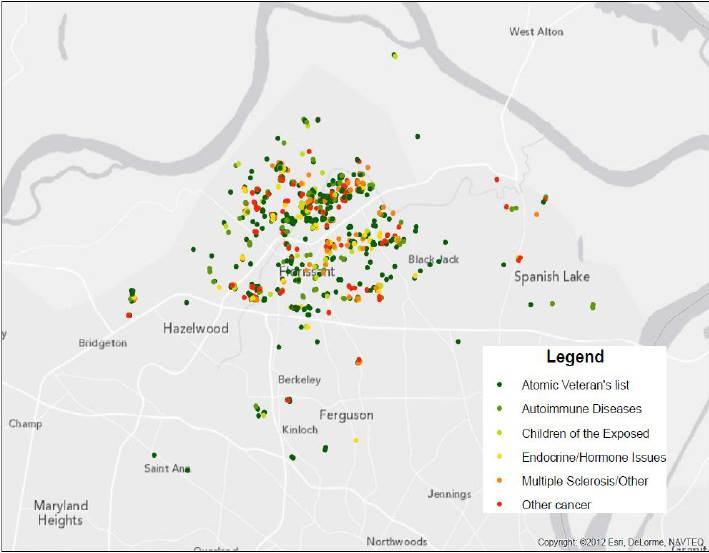
By Blythe Bernhard bbernhard@post-dispatch.com 314-340-8129
An informal survey of 3,300 current and former residents of north St. Louis County shows that more than one-third have developed cancers, a rate the residents blame on radioactive contamination of Coldwater Creek, which runs from St. Ann to the Missouri River.
The findings contradict a state health department report, but a group of women who grew up in North County say they’ll keep pushing for a more thorough investigation.
Cancer is second to heart disease in leading causes of death. One in two men and one in three women will develop cancer at some point in their lives. But the Coldwater Creek group says it’s the rarity of their illnesses, and the young ages at which they strike, which have them questioning the creek. Its water flooded their basements and lured them to play on its banks as children.
“We understand that disease happens, and it’s not always radiation,” said Kim Visintine, a native of Florissant and co-leader of the survey. “We’re talking about extremely high rates and rare episodes.”
Visintine and other McCluer North alumni started a Facebook page a few years ago when they noticed a spike in cancers among childhood friends now in their late 30s and early 40s. The group has since grown to nearly 8,500 members.
A year ago, the leaders launched the survey, which counted 1,242 total cancers among 3,300 people who had lived around the creek. Survey participants reported 202 thyroid cancers or conditions, 113 brain tumors, 37 appendix cancers and 320 auto-immune disorders, the group announced Wednesday. The group did not release further details, including the ages of the survey participants or the dates of their illnesses.

In a report last year, the Missouri health department found no higher risk of cancers linked to radiation for people living in six ZIP codes adjacent to Coldwater Creek, which runs through Florissant, Black Jack and Spanish Lake. Health officials acknowledged the limitations of the report because it didn’t account for people who had moved out of the area.
Diane Schanzenbach, who helped conduct the residents’ survey, said it, too, was limited by size and lack of a control group. They don’t know the total population of the area since the 1950s, when radioactive byproducts from the Mallinckrodt chemical plant in downtown St. Louis were transported in open trucks to a dump site that borders Coldwater Creek near the airport.
“We don’t know if this is 5 percent of the total cases (of cancer) or 50 percent, but my guess is it’s closer to 5 percent,” Schanzenbach said.
Residents are hoping to catch the attention of federal health investigators and get classified as “downwinders” entitled to compensation for radiation exposure linked to atomic bomb production. Investigations into suspected cancer clusters are rarely definitive because of the complexity of the disease and the difficulty in measuring exposures to carcinogens.
The residents shared their data Wednesday with Dr. Dolores Gunn, director of the St. Louis County health department, and a representative from the U.S. Centers for Disease Control and Prevention who was in town for a meeting about all of the nuclear waste sites in the area, including the West Lake Landfill Superfund site in Bridgeton.
The Army Corps of Engineers announced at a meeting Tuesday that fewer than 10 percent of soil and water samples taken from Coldwater Creek last year were contaminated with uranium, thorium or radium. The agency’s cleanup of the airport waste sites and the creek is ongoing.
At least 50 people from North County have sued Mallinckrodt and other companies for their role in nuclear waste production in St. Louis in the World War II and Cold War eras. The plaintiffs claim they were sickened by growing up in housing developments built near the creek in the 1960s and 1970s.
Attorneys for the defendants have said the companies’ operations did not involve the disposal or cleanup of contaminated debris from uranium processing.
Those suing the companies include the father of Jenny Steinmann, who lived in Florissant and crossed Coldwater Creek on her way to school every day. Steinmann died in 2009 at age 23 after cancer spread to her lungs and back. Lead plaintiff Scott McClurg, a professor at Southern Illinois University, ate vegetables grown in his backyrd in Florissant and developed a brain tumor in his 30s. Holly Coil has had more than five addresses in Florissant and was diagnosed with ovarian cancer at 18.
The plaintiffs’ attorneys asked the court last week to allow for amendments to the lawsuits because they “recently obtained facts and expert opinions that permit them to plead they were exposed to radiation in excess of federal dose limits.”
Visintine, one of the leaders of the Coldwater Creek activist group, said their main goal was to alert residents and area doctors.“We need our community to go to their health care providers when they don’t feel right and we need our health care providers to recognize the signs and symptoms of radiation exposure.”
